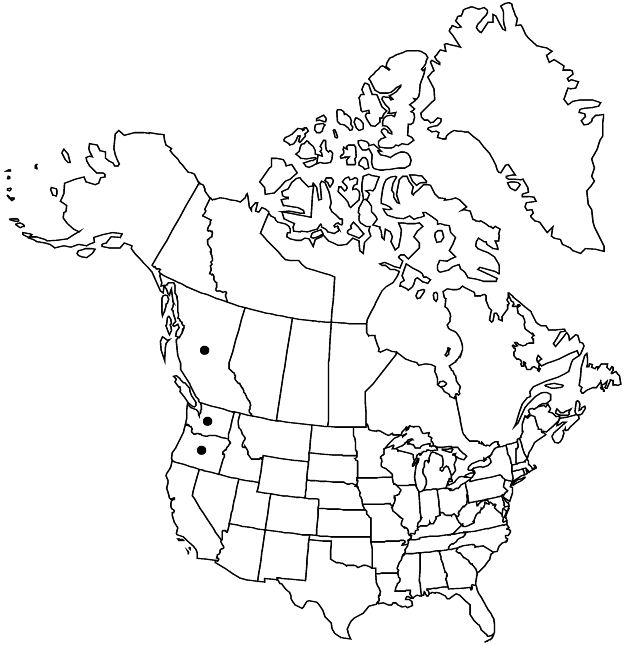Difference between revisions of "Cotoneaster dielsianus"
Bot. Jahrb. Syst. 29: 385. 1900.
FNA>Volume Importer |
imported>Volume Importer |
||
| Line 28: | Line 28: | ||
|elevation=0–500 m | |elevation=0–500 m | ||
|distribution=B.C.;Oreg.;Wash.;Asia (China);introduced also in Europe. | |distribution=B.C.;Oreg.;Wash.;Asia (China);introduced also in Europe. | ||
| + | |introduced=true | ||
|discussion=<p>L. Lingdi and A. R. Brach (2003) included within <i>Cotoneaster dielsianus</i> several taxa recognized here as distinct species, including C. bradyi J. Fryer & E. C. Nelson and <i>C. splendens</i> Flinck & B. Hylmö. Some collections from Oregon approach an undescribed species from China but differ in fruit shape.</p> | |discussion=<p>L. Lingdi and A. R. Brach (2003) included within <i>Cotoneaster dielsianus</i> several taxa recognized here as distinct species, including C. bradyi J. Fryer & E. C. Nelson and <i>C. splendens</i> Flinck & B. Hylmö. Some collections from Oregon approach an undescribed species from China but differ in fruit shape.</p> | ||
|tables= | |tables= | ||
| Line 52: | Line 53: | ||
|publication year=1900 | |publication year=1900 | ||
|special status=Introduced | |special status=Introduced | ||
| − | |source xml=https:// | + | |source xml=https://bibilujan@bitbucket.org/aafc-mbb/fna-data-curation.git/src/bb6b7e3a7de7d3b7888a1ad48c7fd8f5c722d8d6/coarse_grained_fna_xml/V9/V9_787.xml |
|subfamily=Rosaceae subfam. Amygdaloideae | |subfamily=Rosaceae subfam. Amygdaloideae | ||
|tribe=Rosaceae tribe Gillenieae | |tribe=Rosaceae tribe Gillenieae | ||
Revision as of 01:33, 28 May 2020
Shrubs, 2–4 m. Stems narrowly erect, spreading; branches distichous, grayish brown, initially tomentose-pilose. Leaves deciduous; petiole 2–5 mm, tomentose-pilose; blade ovate to elliptic or broadly ovate, 9–38 × 7–23 mm, coriaceous or subcoriaceous, base obtuse or cuneate, margins flat, not revolute, veins 2–4, lightly sunken, apex acute or acuminate, abaxial surfaces densely grayish tomentose, adaxial dark green to grayish green, shiny, not glaucous, flat, rarely slightly bulging, between lateral veins, slightly rugose, pilose; fall leaves bright yellow to orange or red. Inflorescences on fertile shoots 10–35 mm with 4 leaves, 2–7(–10)-flowered, compact. Pedicels 1–3 mm, tomentose-strigose. Flowers erect, 6–7.5 mm, closed; hypanthium funnelform, proximally tomentose-strigose, distally tomentose-pilose; sepals: margins reddish tomentose, borders purple, broad, glabrous, apex cuspidate or apiculate, surfaces pilose; petals erect-incurved, dark pink to red, base dark red, margins off-white; stamens 14–20, filaments red to dark red, anthers white; styles 3 or 4(or 5). Pomes bright red, broadly obovoid, sometimes globose or depressed-globose, 5–9.1 × 5.1–8.8 mm, slightly shiny, not glaucous, pilose; sepals flat, tomentose; navel open; style remnants 1/2–2/3 from base. Pyrenes 3 or 4(or 5).
Phenology: Flowering May–Jun; fruiting Aug–Mar.
Habitat: Edges of woods, disturbed forests, flood plains, thickets, waste ground, cliffs, meadows, brushy wet prairie remnants
Elevation: 0–500 m
Distribution

Introduced; B.C., Oreg., Wash., Asia (China), introduced also in Europe.
Discussion
L. Lingdi and A. R. Brach (2003) included within Cotoneaster dielsianus several taxa recognized here as distinct species, including C. bradyi J. Fryer & E. C. Nelson and C. splendens Flinck & B. Hylmö. Some collections from Oregon approach an undescribed species from China but differ in fruit shape.
Selected References
None.